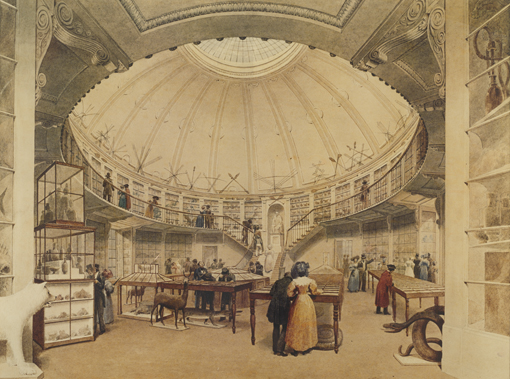This was originally published in March 2012 as part of our Item of the Month series.
Did you know there was once a museum at the University? This month we take a look at a watercolour by John Alexander Gilfillan, Professor of Drawing and Painting (1830–1841) at Anderson’s Institution. The painting, c. 1831, depicts the interior of the Andersonian Museum, once the public face of Anderson’s University.

John Anderson, the founder of Anderson’s Institution, left instructions in his will for the formation of a place of useful learning. Anderson also left his ‘curiosities’ to the new institution. These ‘curiosities’ included a large collection of coins, medals, Tassie gems and a valuable collection of fossils. In March 1796, the Managers of Anderson’s Institution rented the middle storey of the grammar school in George Street to be used as a “Museum, Lecturing Room and Library”. In 1799, the museum moved to new premises on the corner of John Street and Ingram Street.
Anderson was the first person to donate to the museum but others soon followed. James Smith of Jordanhill designed the interior of the building and donated a large collection of coins and medals. Thomas Edington II presented mineral specimens, animals and birds from the Cape, Australasia and the South Seas and South America. In 1830, 2000 stuffed birds were purchased for the museum from Mr Joseph Sabrine of London. It fell upon the janitor at the time, Alexander Johnstone, to make the long and arduous journey to London to collect them and bring them back to Glasgow.
During 1828 the museum moved back to the old grammar school in George Street when the managers purchased the building for £3000. In April 1830, plans were submitted to build on the back of the old school; there would be a lecture theatre on the ground floor with the museum above this, topped with a dome.
The museum was not only used by the students; on Wednesdays, Sundays and certain holidays, admission was extended to the public. The normal cost of entry in the 1840s was 2 ½ d. and 1 d. on public holidays. The admission fees meant that it was mainly the middle classes who frequented the museum at this time. However, during 1852, a special Saturday evening charge of one old penny was introduced. This special price certainly increased numbers; between 5th November and 22nd December 1852, the museum attracted 5, 391 visitors, an average of 770 a day (not bad for a Saturday night at the museum!).
The museum continued to attract a large amount of visitors. During the New Year holiday, 1869/1870, over 2000 people visited it. However, the later decades of the 19th century witnessed its decline. A number of coins were stolen in 1870, indicating slackness in security. Numbers of visitors also declined; by 1880 the average attendance (excluding holidays) had fallen to three per week. The following decade saw the museum only open two days a week.
The formation of the Glasgow and West of Scotland Technical College in 1887 witnessed a move in favour of the technical subjects. The museum items were no longer needed for teaching purposes, and items which were not used by the students were transferred. The ground floor of the museum was converted into a reading room in 1882. The museum closed completely when the new Royal Technical College building opened in 1902. The museum pieces were largely transferred to other institutions or put into storage.
We can only imagine what the museum may have looked like but Gilfillan’s detailed watercolour gives us a good idea of what was on show there in 1831.
Rachel Pike, Archives Assistant